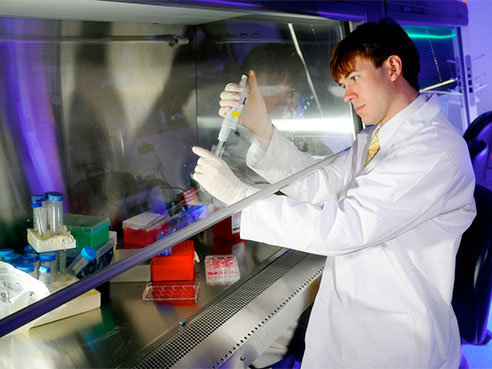Need more information? Contact us
 The Department of Biomedical Engineering at the University of Alabama at Birmingham is expanding its reach, after the University of Alabama System Board of Trustees voted recently to establish Biomedical Engineering as a joint department between the schools of Engineering and Medicine.
The Department of Biomedical Engineering at the University of Alabama at Birmingham is expanding its reach, after the University of Alabama System Board of Trustees voted recently to establish Biomedical Engineering as a joint department between the schools of Engineering and Medicine. Since 1979, the Department of Biomedical Engineering has resided wholly within the School of Engineering. By integrating the department into the School of Medicine, administrators say they hope to capitalize on existing and emerging strengths in research, education and patient care at UAB.
“Creating a joint department with the School of Medicine marks a natural progression for biomedical engineering at UAB,” said Iwan Alexander, Ph.D., dean of the School of Engineering. “The department has long benefited from UAB’s reputation for world-class research and education in medicine and health sciences. Making the department a part of Engineering and Medicine will bring engineering faculty and students closer to clinicians and medical research from both schools — which will, in turn, allow them to develop closer relationships through joint research and education programs.”
From the medical perspective, biomedical engineering adds a dimension that will increase the scope of research and patient care, according to Selwyn M. Vickers, M.D., senior vice president for Medicine at UAB and dean of the School of Medicine.
| “Making Biomedical Engineering a joint department combines the natural strengths and talents of UAB. The new structure will allow us to more easily recruit faculty and execute strategically toward creating devices or biological systems that advance human healing.” |
With the creation of this joint department, UAB joins the ranks of several elite universities that have biomedical engineering departments with similar partnerships with medical schools. Timothy Wick, Ph.D., chair of the department since 2005, says such an arrangement is particularly fitting for UAB, where several members of the university leadership have strong backgrounds in both engineering and medicine. UAB President Ray L. Watts, M.D., received his undergraduate degree from the UAB School of Engineering and served at UAB as senior vice president for Medicine and dean of the School of Medicine. Provost Linda Lucas, Ph.D., also graduated from the school before going on to serve as chair of the Department of Biomedical Engineering and later as dean of the School of Engineering.
“For an arrangement like this to be successful, you need strong leadership that is committed to the development of translational science and the kind of entrepreneurial research this department has historically been known for,” Wick said. “We have that kind of leadership at the university level, as well as in both the engineering and medical schools. By creating a joint department, we will be better able to compete for funding, as well as for top faculty and students.”
Historically, biomedical engineers at UAB have collaborated with clinicians and medical researchers on a limited basis through various centers or individual research projects. By integrating the department into the medical school, Wick says he expects to see an increase in interdisciplinary research, as well as new interdisciplinary programs that will facilitate the transition from the laboratory to the clinic.
“A focus on patient health has always been implicit in our mission as biomedical engineers,” Wick said. “Working more closely with research scientists and clinicians will allow us to accelerate understanding of disease processes and develop new treatments faster to treat chronic and acute disease conditions.”
For example, biomedical expertise in regenerative medicine, which includes the use of scaffolds and 3-D printing for organ development, illustrates the confluence of physical sciences and biological sciences. Another example is the creation of therapeutic delivery devices for people with diabetes or cardiovascular disease.
“In order to make significant advances in medicine, we need the ability to bring intellectual resources from multiple disciplines to bear on research and patient care,” Vickers said.
“Ultimately, the devices and products that are developed through biomedical engineering must find their way into the hospitals,” Alexander said. “This helps accelerate that process by integrating the biomedical engineers into the medical-school structure.”
